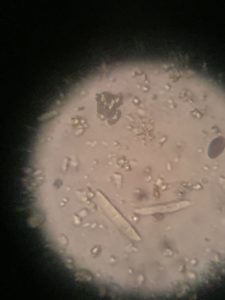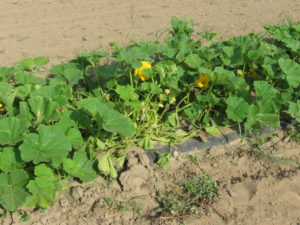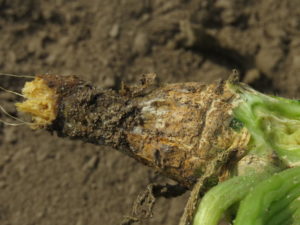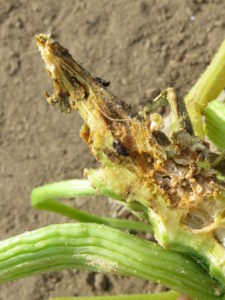Winter squash – butternut, acorn, and kabocha – in our downy mildew sentinel plot at Pinney Purdue were showing some wilted and stunted plants by late July (Figure 1). They are easily pulled up, the stem breaking off at ground level, revealing a brown stringy decayed-looking stem base (Figure 2). Sometimes there is a little whitish or maybe pinkish mold on the stem. I cut open a kabocha squash to look for squash vine borer larva and found sap beetles that seemed to be feeding inside the stem, but no vine borer (Figure 3). The sap beetles were clearly taking advantage of an opportunity, but not the cause of the wilt. Perhaps a borer had already come and gone. I used scotch tape to pick up some of the mold and put it on a slide to look at under the microscope. At 100X and 400X I saw among the particles of soil what I remember from my plant pathology class as ‘banana spores’ (Figure 4). These are typical of fusarium. I saw none of the lemon or football shaped spores of phytophthora. So my guess is that this is fusarium crown rot. To be certain, I would send a sample to the Plant and Pest Diagnostic Lab at Purdue, https://ag.purdue.edu/btny/ppdl/Pages/default.aspx. Information on management of diseases of pumpkins, including fusarium crown rot, is available in Purdue Extension Bulletin BP-17 https://www.extension.purdue.edu/extmedia/BP/BP-17/BP-17.pdf .

Figure. 4. Spores from stem of wilted kabocha squash observed under microscope (400X). Spores are the larger elongated structures with horizontal segmentation visible.
One of the cucumber plants in the downy mildew plot was wilting as well. Cucumbers in another area were also wilting, and some of the muskmelon vines are wilting too. We had heavy pressure from striped cucumber beetles, and this is most likely bacterial wilt; the disease they transmit, which replicates in the xylem, clogging water movement and leading to wilt. In one of the plants we performed the classic test of looking for strings of bacteria-laden sap between two cut edges of stem, and found them. A much younger Dan Egel shows how to do the test in this video: https://www.youtube.com/watch?v=dt8HLco12kM.
Pumpkins in the no-till demonstration and in conventional plots were showing yellowing on lower leaves as well as wilting. These plants have not received much irrigation, so they probably experienced some drought stress. There could be squash vine borer larvae in some of the plants; the moths were seen in the area in early July. To check for squash vine borer, look for a hole near the base of them stem. Usually there is some mushy yellowish frass (insect poop) coming out of the hole when the vine borer is present. If there is a hole, cut open the stem of the plant and look for the dark-headed white larva that may get over an inch long. See Vegetable Crops Hotline issue 651 ‘What’s Eating My Squash‘ for more information and images of squash vine borer.
For images and more information about striped cucumber beetle, squash vine borer, and other insect pests of cucurbits see Purdue Extension Bulletin E-30 https://extension.entm.purdue.edu/publications/E-30/E-30.html .
For all three of these issues–fusarium crown rot, bacterial wilt, and squash vine borer–once the problem occurs there is little chance of ‘cure’ for the affected plant. Identifying the problem will provide information that may help you protect other plants in the crop, and plan for preventive practices to reduce problems in future years.


